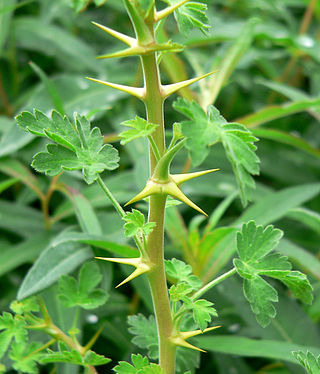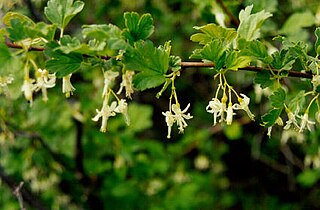Related Research Articles

Gooseberry is a common name for many species of Ribes, as well as a large number of plants of similar appearance. The berries of those in the genus Ribes are edible and may be green, orange, red, purple, yellow, white, or black.

Ribes is a genus of about 200 known species of flowering plants, most of them native to the temperate regions of the Northern Hemisphere. The various species are known as currants or gooseberries, and some are cultivated for their edible fruit or as ornamental plants. Ribes is the only genus in the family Grossulariaceae.

Ribes uva-crispa, known as gooseberry or European gooseberry, is a species of flowering shrub in the currant family, Grossulariaceae. It is native to Europe, the Caucasus and northern Africa. Gooseberry bushes produce an edible fruit and are grown on both a commercial and domestic basis. Its native distribution is unclear, since it may have escaped from cultivation and become naturalized. For example, in Britain, some sources consider it to be a native, others to be an introduction. The species is also occasionally naturalized in scattered locations in North America.

The shrub Ribes lacustre is known by the common names prickly currant, black swamp gooseberry, and black gooseberry. It is widely distributed in North America.
Gooseberry most often refers to a cultivated plant from two species of the genus Ribes:

Ribes divaricatum is a species in the genus Ribes found in the forests, woodlands, and coastal scrub of western North America from British Columbia to California. The three accepted varieties have various common names which include the word "gooseberry". Other common names include coast black gooseberry, wild gooseberry, Worcesterberry, or spreading-branched gooseberry.

Ribes speciosum is a species of flowering plant in the family Grossulariaceae, which includes the edible currants and gooseberries. It is a spiny deciduous shrub with spring-flowering, elongate red flowers that resemble fuchsias, though it is not closely related. Its common name is fuchsia-flowered gooseberry. It is native to central and southern California and Baja California, where it grows in the scrub and chaparral of the coastal mountain ranges.
Ribes binominatum is a species of currant known by the common names trailing gooseberry and ground gooseberry.

Ribes inerme is a species of currant known by the common names whitestem gooseberry and white stemmed gooseberry. It is native to western North America from British Columbia to California and eastward to the Rocky Mountains. It grows in mountain forests, woodlands, and meadows.
Ribes lasianthum is a species of currant known by the common names alpine gooseberry and woolly-flowered gooseberry. It is native to California, where it can be found in the San Gabriel Mountains and the Sierra Nevada, its distribution extending just into Nevada.

Ribes montigenum is a species of currant known by the common names mountain gooseberry, alpine prickly currant, western prickly gooseberry, and gooseberry currant. It is native to western North America from Washington south to California and east as far as the Rocky Mountains, where it grows in high mountain habitat types in subalpine and alpine climates, such as forests and talus. It is a spreading shrub growing up to 1.5 meters tall, the branching stems covered in prickles and hairs and bearing 1 to 5 sharp spines at intervals.

Ribes quercetorum is a species of currant known by the common names rock gooseberry, oak gooseberry and oakwoods gooseberry. It is native to the mountains and hills of California from the San Francisco Bay Area south into Baja California and east into Arizona.

Ribes roezlii is a North American species of gooseberry known by the common name Sierra gooseberry.

Ribes thacherianum, with the common name Santa Cruz gooseberry, or Santa Cruz Island gooseberry, is a rare North American species of currant found only on one island off the coast of California.

Ribes velutinum is a species of currant known by the common name desert gooseberry.
Californian fuchsia or California fuchsia may refer to one of two plant species:

Ribes cynosbati is a North American species of shrub in the family Grossulariaceae. It is native to the eastern and central United States and Canada. It has several common names, including prickly gooseberry, eastern prickly gooseberry, dogberry, and dog bramble. It grows in rich forests, rocky slopes, and open heaths from New Brunswick south along the Appalachian Mountains to northern Alabama and west as far as Manitoba, the Dakotas and Oklahoma.

Ribes curvatum is a North American species of currant known by the common names granite gooseberry, drooping gooseberry and Georgia gooseberry. It is native to the southeastern and south-central United States, and can be found in habitats ranging from dry rocky slopes to rich woodlands.

Ribes niveum is a North American species of currant known by the common names snowy gooseberry, white-flowered gooseberry, or snow currant. It is native to the western United States.
References
- ↑ "Fuchsiaflower Gooseberry, Ribes speciosum". calscape.org. Retrieved 2023-12-10.